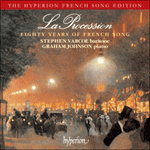The first word of this enchanting barcarolle (in 6/8 of course) is ‘Murmure’ and the gently rocking accompaniment is as good as the poet’s word – the semiquaver water music lapping and undulating in an aquatic equivalent of a lover’s murmured endearments. The song was originally conceived for the young tenor Victor Capoul (a recording exists of him singing the
Berceuse from Godard’s
Jocelyn). Capoul was part of the original cast of Gounod’s
Roméo et Juliette which was prepared under Bizet’s supervision, and from this song we must assume that he had an exquisite command of both mezza voce and coloratura. The composer reduces Lamartine’s poem from eighteen to three verses without much scruple, and it must be admitted we do not notice the butchery, so charming is the music and so hypnotic is the use of a tonic pedal device (there is a shift to the dominant, another long pedal point, only on the song’s third page). The composer’s mastery of long-spanned harmonic structures such as these is a sure sign of a musical brain used to planning dramatic tension over an entire operatic act. We can detect the influence of Gounod, and Berlioz too (
Sur les lagunes), but the water glows luminously under Bizet’s own inimitable stage lighting.
from notes by Graham Johnson © 1998
Le premier mot de cette barcarolle enchanteresse (à 6/8, bien sûr), est «Murmure», et l’accompagnement doucement oscillant est aussi beau que le mot du poète – la musique aquatique en doubles croches bondissant et ondoyant dans un équivalent aquatique de mots tendres murmurés par un amoureux. Cette chanson fut initialement écrite pour le jeune ténor Victor Capoul (il existe un enregistrement de lui dans la
Berceuse du
Jocelyn de Godard), qui fit partie de la distribution originale du
Roméo et Juliette de Gounod, préparé sous la direction de Bizet, et nous pouvons donc supposer qu’il dominait exquisément la mezza voce et la coloratura. Le compositeur fait passer le poème de Lamartine de dix-huit à trois strophes, sans grand scrupule, et force est de reconnaître que nous ne remarquons rien de ce carnage, tant la musique est charmante. La maîtrise de Bizet en matière de longues structures harmoniques, telles que celles-ci, est le signe infaillible d’un cerveau musical habitué à concevoir une tension dramatique sur tout un acte d’opéra. Nous pouvons déceler l’influence de Gounod, et aussi de Berlioz (
Sur les lagunes), mais l’eau rougeoie mystérieusement sous l’éclairage scénique, inimitable, de Bizet.
extrait des notes rédigées par Graham Johnson © 1998
Français: Hypérion


 La Procession
La Procession
